To include more micronutrients in your meals, focus on incorporating colorful vegetables, whole grains, nuts, seeds, and lean proteins. Each hue in vegetables represents different vitamins and minerals, enhancing nutrient absorption. Opt for whole grains like quinoa for added fiber and nutrients. Nuts and seeds pack a nutrient-dense punch and support heart health. Don't overlook lean proteins, which aid in nutrient absorption. Experimenting with herbs and spices can also boost micronutrient intake significantly. Lastly, planning balanced meals and checking labels ensures you get the essential nutrients your body needs. You might discover even more helpful tips along the way.
Key Takeaways
- Incorporate a variety of colorful vegetables in meals to enhance nutrient diversity and absorption.
- Choose whole grains like quinoa and barley for essential vitamins, minerals, and fiber.
- Add nuts and seeds to dishes for healthy fats and micronutrients that support immune function.
- Include lean proteins, such as chicken or fish, to provide essential amino acids that aid nutrient absorption.
- Experiment with fermented foods and herbs/spices to boost micronutrient intake and gut health.
Understand Micronutrients
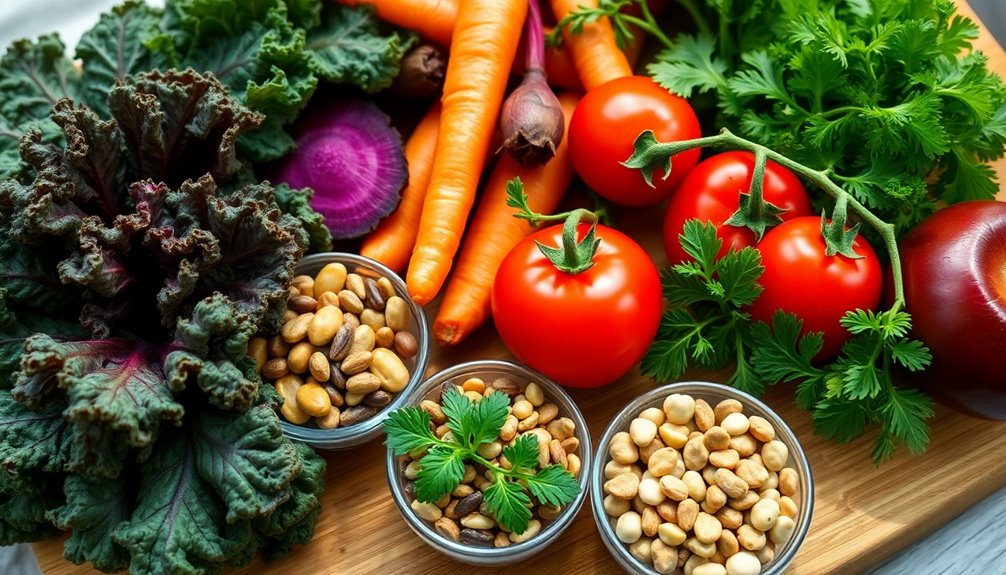
Micronutrients are necessary vitamins and minerals your body needs in small amounts for peak health. They play a pivotal role in various bodily functions, including immune support, energy production, and bone health. Understanding the importance of these micronutrients can empower you to make informed dietary choices that enhance your well-being.
Micronutrient absorption is just as crucial as the nutrients themselves. Your body must effectively absorb these vitamins and minerals to reap their benefits. Factors like gut health, age, and certain medications can influence absorption rates.
If your diet lacks diversity, you might be at risk for micronutrient deficiency, which can lead to serious health issues, including fatigue, weakened immunity, and impaired cognitive function.
You may consider supplementation if you're unable to meet your micronutrient needs through food alone. However, it's vital to approach supplementation thoughtfully. Not all supplements are created equal, and excessive intake can lead to toxicity or interfere with other nutrients. Ideally, focus on whole food sources to provide the nutrients your body craves. A plant-based diet, rich in antioxidants and fiber, offers a natural way to enhance your micronutrient intake.
Choose Colorful Vegetables
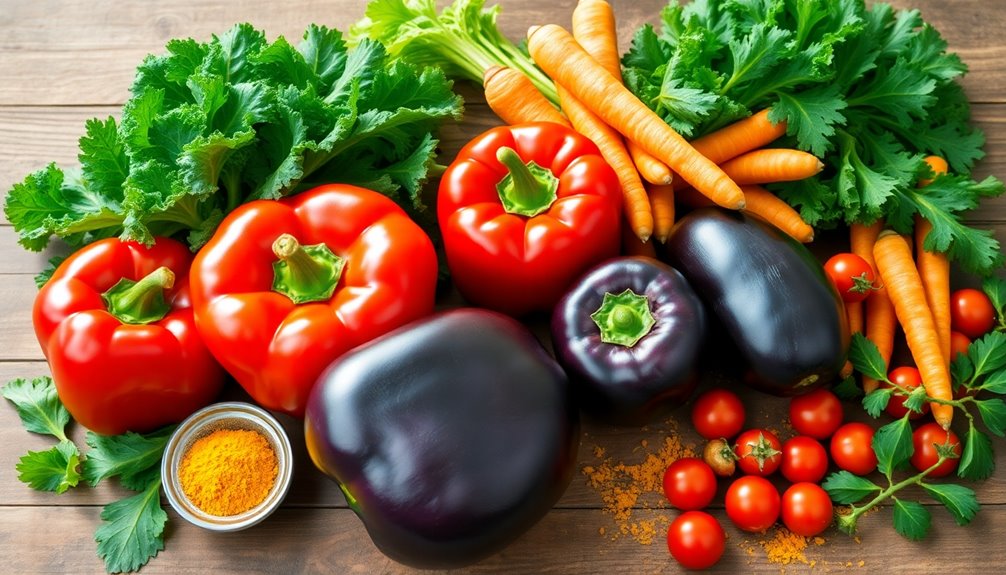
Brighten your plate with a variety of colorful vegetables to enhance your micronutrient intake. Each color represents different vitamins and minerals, so including a spectrum of hues guarantees you're receiving a well-rounded nutrient profile. For example, red bell peppers are packed with vitamin C, while leafy greens like spinach are rich in iron and folate.
Think about your food pairings; combining vegetables can improve both flavor and nutrient absorption. Pairing carrots with a little bit of healthy fat, such as olive oil, boosts the absorption of their beta-carotene. Similarly, adding citrus to your salads not only enhances taste but also improves the absorption of iron from spinach and other leafy greens.
When it comes to cooking methods, opt for steaming, roasting, or sautéing your vegetables instead of boiling them. These methods help preserve essential micronutrients while also bringing out their natural flavors. For instance, roasting broccoli with garlic not only makes it delicious but also maintains its vitamin C content better than boiling would.
Lastly, don't shy away from trying new vegetable combinations. Mixing purple cabbage with orange carrots in a slaw not only looks appealing but also maximizes your nutrient intake. By focusing on colorful vegetables, you're not just making your meals visually appealing; you're also nourishing your body and fostering a sense of community around healthy eating. Incorporating a custom keto diet plan can also help you ensure you're meeting your micronutrient needs while enjoying delicious meals. So, fill your plate with vibrant veggies and enjoy the many benefits they bring!
Incorporate Whole Grains
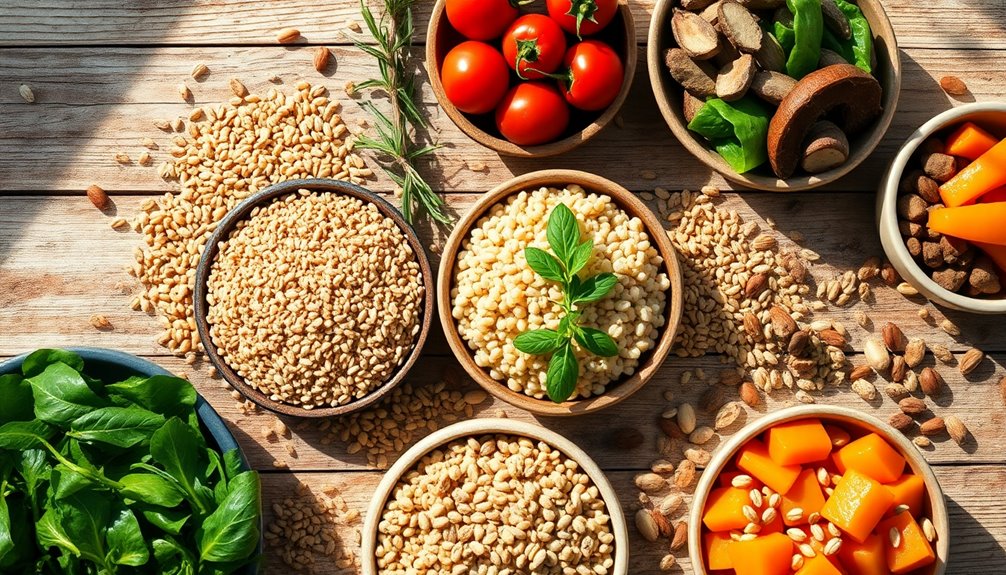
Incorporating whole grains into your meals is a simple yet powerful way to boost your micronutrient intake. Whole grains are packed with essential vitamins, minerals, and fiber, making them a fantastic addition to any diet. By making whole grain swaps, you can easily elevate your meals without sacrificing taste. For instance, choose whole grain bread instead of white bread or opt for brown rice instead of white rice. These small changes can greatly enhance your nutrient profile.
Exploring grain variety is another effective strategy. Instead of sticking to the same grains, try incorporating quinoa, barley, or farro into your meals. Each of these grains brings unique micronutrients to the table. Quinoa, for example, is a complete protein, while barley is rich in vitamins B6 and E. By diversifying your grain choices, you not only improve your nutritional intake but also add excitement to your meals.
You can also experiment with whole grain pasta or oats in breakfast dishes. Whole grain pasta provides a hearty base for your favorite sauces, while oatmeal can be topped with fruits and nuts for a nutritious start to your day. The key is to embrace the flexibility that whole grains offer, making it easy to fit into your lifestyle.
Add Nuts and Seeds
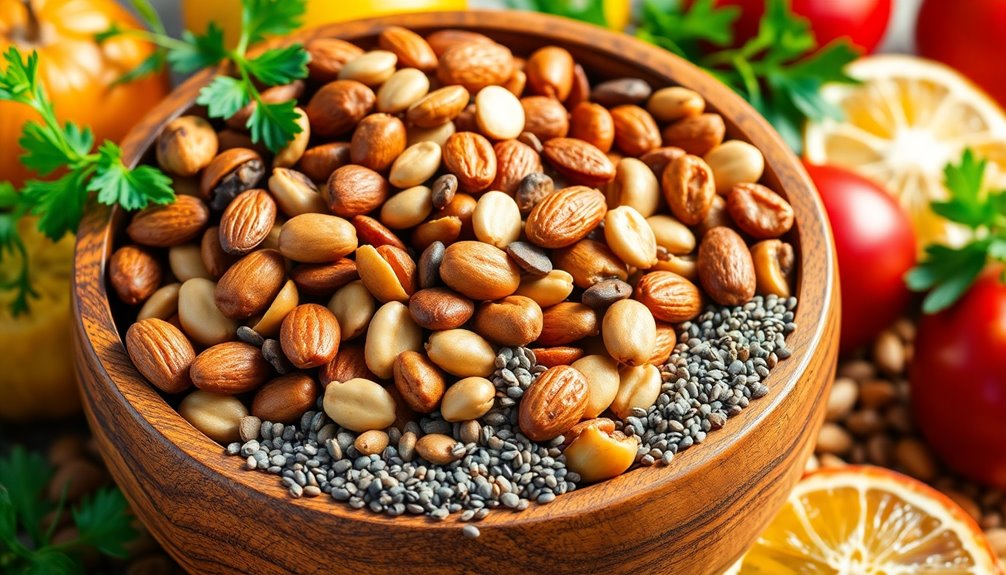
Enhancing your meals with nuts and seeds can greatly elevate your overall nutrition. These tiny powerhouses are packed with micronutrients, healthy fats, and fiber, making them a fantastic addition to your diet. By incorporating nuts and seeds into your meals, you not only enjoy nutrient-dense snacks but also boost your intake of essential vitamins and minerals.
Nuts like almonds, walnuts, and pistachios are rich in vitamin E, magnesium, and antioxidants. Seeds, such as chia, flax, and pumpkin, provide additional benefits, including omega-3 fatty acids and zinc. These micronutrients play critical roles in supporting your immune system, enhancing brain function, and promoting heart health. Furthermore, adding plant-based protein sources like nuts and seeds can be particularly beneficial for those following a vegan diet.
You can easily integrate nuts and seeds into your daily routine. Toss a handful of chopped nuts into your morning oatmeal or yogurt for added texture and flavor.
Sprinkle seeds over salads, or blend them into smoothies for a creamy consistency. They also serve as convenient and satisfying plant-based proteins, making them ideal for snacking between meals.
When you choose nuts and seeds, you're not just making a healthy choice; you're also connecting with a community that values wholesome eating. So go ahead and experiment with different varieties to find what you love. By adding these nutrient-dense options to your meals, you'll feel more energized and nourished, fostering a sense of belonging in your health journey.
Opt for Lean Proteins

Choosing lean proteins can significantly enhance your meal's nutritional profile. Lean proteins, such as chicken breast, turkey, fish, and plant-based options like lentils and quinoa, are excellent protein sources that provide essential amino acids without excessive saturated fats. By including these choices in your meals, you're not only nourishing your body but also supporting better overall health.
One of the key benefits of opting for lean proteins is their role in improving nutrient absorption. When you consume lean proteins alongside colorful vegetables and whole grains, you create a balanced plate that promotes efficient digestion and absorption of vitamins and minerals. Additionally, incorporating mini bands in your fitness routine can complement your healthy eating habits by enhancing muscle tone and metabolism.
For example, pairing grilled chicken with a side of steamed broccoli and brown rice not only offers a wealth of nutrients but also helps your body utilize those nutrients more effectively.
Moreover, lean proteins help you feel satisfied longer, which can aid in maintaining a healthy weight. When you satisfy your hunger with nutrient-dense options, you're less likely to reach for processed snacks that can derail your health goals.
Incorporating lean proteins into your diet fosters a sense of community and belonging, as you can enjoy meals with family and friends while sharing delicious, health-conscious recipes. So, next time you plan your meals, think about how you can make lean proteins the star of your dishes. Your body will thank you for it, and you'll feel great knowing you're making choices that benefit your health and well-being.
Utilize Fermented Foods

Adding fermented foods to your meals can greatly enhance your intake of beneficial nutrients. These foods aren't just delicious; they also support gut health and offer a range of probiotic benefits that can help you feel your best. By incorporating fermented foods, you'll not only diversify your diet but also boost your overall well-being. Additionally, drinking water from SlimCrystal bottles can boost energy levels and further enhance your health journey.
Here are four easy ways to include fermented foods in your meals:
- Start with yogurt: Opt for plain, unsweetened yogurt packed with live cultures. You can add it to smoothies or enjoy it with fruit for a nutritious snack.
- Incorporate sauerkraut: This tangy side dish is rich in vitamins C and K. Use it as a topping for sandwiches or salads to add crunch and flavor.
- Try kimchi: A staple in Korean cuisine, kimchi is spicy and full of probiotics. Add it to rice bowls or enjoy it as a side dish to enhance your meals.
- Experiment with kefir: This fermented milk drink is versatile and can be used in smoothies, salad dressings, or even as a base for soups.
Experiment With Herbs and Spices

Exploring the world of herbs and spices can greatly boost the micronutrient content of your meals while adding depth and flavor. These culinary powerhouses not only enhance taste but also pack a punch of vitamins, minerals, and antioxidants. By incorporating a variety of herbs and spices into your cooking, you can create flavorful combinations that make every dish more nutritious and enjoyable.
Start by experimenting with some common options. Basil, for instance, is rich in vitamin K, while cilantro provides a good dose of vitamin A and C. Turmeric, known for its anti-inflammatory properties, is another excellent choice, adding both color and health benefits to your meals. Don't hesitate to mix and match these ingredients; the right combination can transform an ordinary dish into something extraordinary.
Utilizing different cooking techniques can also enhance the benefits of herbs and spices. For example, sautéing garlic in olive oil before adding vegetables can release its potent nutrients while infusing your dish with flavor. Additionally, incorporating nutrient-rich ingredients can further improve the overall health profile of your meals and support your well-being.
Similarly, roasting spices can intensify their aroma and taste, making your meals more inviting.
Select Seasonal Produce

Seasonal produce is often the best choice for enhancing your meals with essential micronutrients. When you choose fruits and vegetables that are in season, you not only get fresher options, but you also support local farmers and the environment. Plus, seasonal produce is often more affordable, making it easier to include in your meal planning.
To make the most of seasonal produce, consider these tips:
- Visit a Farmers Market: These markets often feature local growers who sell fresh, in-season produce. You'll find a variety of nutrient-dense options while enjoying a community atmosphere.
- Plan Your Meals: Incorporate seasonal fruits and vegetables into your weekly meal planning. Look for recipes that highlight these ingredients, ensuring you get a diverse range of micronutrients.
- Experiment with New Varieties: Seasonal produce offers the perfect opportunity to try new fruits and vegetables you may not usually buy. This can keep your meals exciting and packed with different nutrients.
- Store and Preserve: If you find an abundance of seasonal produce, consider freezing or canning some for later use. This way, you can continue to enjoy those nutritional benefits even when the season changes. Additionally, incorporating seasonal produce can help support liver health due to their rich nutrient profiles that aid in liver function.
Plan Balanced Meals
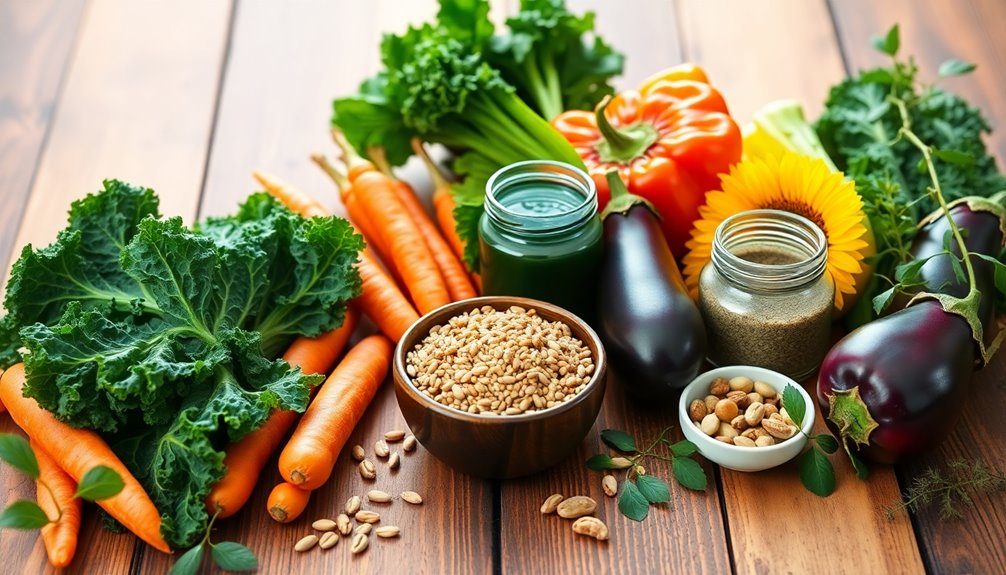
Planning well-rounded meals is important for guaranteeing you receive a wide variety of essential micronutrients. When you focus on portion control, you can better manage your intake of vitamins and minerals while keeping your energy levels steady. Start by picturing your plate: aim for half filled with colorful fruits and vegetables, a quarter with whole grains, and a quarter with lean proteins. This equilibrium not only supports your health but also creates meals that are satisfying and enjoyable.
Meal timing plays a vital role too. Regularly scheduled meals help regulate your metabolism and keep your nutrient levels stable throughout the day. Try to eat every three to four hours, incorporating snacks like nuts or yogurt rich in micronutrients. Additionally, maintaining a strong core and properly activated glutes can enhance overall movement efficiency during meal preparation.
Consider your cooking methods as well. Steaming, roasting, and sautéing retain more nutrients compared to frying. Experiment with different techniques to find what you enjoy while maximizing micronutrient content.
Meal prep can simplify your week and make sure you have well-rounded options ready when hunger strikes. Spend some time each week planning and preparing meals. This way, you can make healthier choices without the pressure of last-minute decisions.
Educate Yourself on Labels

Understanding food labels is crucial for making informed dietary choices, and it can significantly impact your micronutrient intake. By mastering how to read labels, you can easily identify nutrient-rich foods to enhance your meals. Here are four key steps to help you navigate food labels effectively:
- Check Serving Sizes: Always start by looking at the serving size. It sets the standard for the nutritional information listed. If you're consuming more than the stated amount, be sure to adjust the nutrient values accordingly.
- Reading Ingredients: The ingredient list reveals what's really in your food. Aim for items that are whole and minimally processed. Ingredients are listed in descending order by weight, so prioritize products where micronutrient-rich ingredients appear at the top.
- Look for Vitamins and Minerals: Focus on the percentage of daily values (DV) for vitamins and minerals. Aim for foods that provide at least 20% DV for nutrients like vitamin A, vitamin C, calcium, and iron. Additionally, consider how the Keto diet can help you prioritize foods that are nutrient-dense while supporting your health goals.
- Watch for Added Sugars and Sodium: Be cautious of products high in added sugars and sodium, as these can detract from your overall nutrient intake. A good rule of thumb is to choose items with no more than 5% DV for these components.
Frequently Asked Questions
What Are the Best Sources of Vitamin D in Foods?
When you're looking for the best sources of vitamin D, consider fatty fish like salmon, mackerel, and sardines.
Fortified foods, like milk and cereals, can also boost your intake. Remember, absorption factors play a key role; pairing these foods with healthy fats enhances vitamin D absorption.
Spending time in sunlight helps too, as your skin naturally produces vitamin D.
Prioritizing these sources can help you meet your nutritional needs effectively.
How Can I Identify Micronutrient Deficiencies in My Diet?
Did you know that nearly 90% of people don't get enough micronutrients in their diets? To identify deficiencies, you can start with a dietary assessment, tracking what you eat. Look for symptoms like fatigue, hair loss, or weakened immunity. Blood tests can confirm specific deficiencies and reveal health risks associated with them. By understanding your nutrient intake, you can take steps towards a healthier, more balanced diet that supports your well-being.
Are There Any Supplements for Micronutrients Worth Taking?
When considering supplements for micronutrients, it's important to evaluate their effectiveness. Some studies suggest certain supplements can enhance micronutrient absorption, especially if your diet's lacking. However, not all supplements are created equal, so it's wise to choose high-quality brands.
You should also consult a healthcare professional to tailor your choices to your specific needs. Remember, it's best to prioritize whole foods, but supplements can help fill gaps when necessary.
How Do Cooking Methods Affect Micronutrient Content in Food?
Cooking methods notably affect the micronutrient content in your food.
For instance, roasting can preserve vitamins better than boiling, which often leaches nutrients into the water.
Steaming is generally a great option, as it retains more nutrients compared to boiling.
Grilling can enhance flavor without sacrificing too many vitamins, but be cautious of charring, which may create harmful compounds.
Choosing your cooking method wisely can help you get the most out of your meals.
Can I Get Enough Micronutrients From a Vegan Diet?
Yes, you can absolutely get enough micronutrients from a vegan diet! By incorporating a variety of plant-based alternatives, you can guarantee a diverse nutrient intake. Focus on foods like leafy greens, nuts, seeds, and whole grains.
Remember that nutrient bioavailability varies, so pairing foods strategically—like consuming vitamin C-rich foods with iron sources—can improve absorption.
With proper planning, a vegan diet can meet all your micronutrient needs while promoting a sense of community and belonging.
Conclusion
By weaving a tapestry of colorful vegetables, whole grains, nuts, and lean proteins into your meals, you're not just eating; you're nourishing your body with crucial micronutrients. Each bite becomes a step toward better health, enhancing your energy and well-being. Remember to explore seasonal produce and experiment with herbs and spices to keep your meals exciting. So, take charge of your nutrition journey—your body deserves a vibrant, nutrient-rich plate every day.



